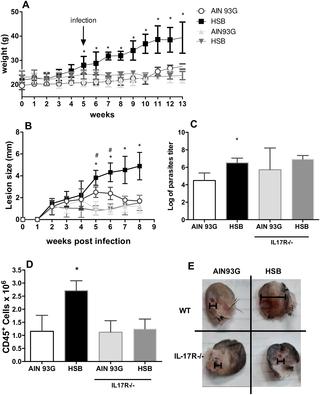当前位置:
X-MOL 学术
›
PLOS Negl. Trop. Dis.
›
论文详情
Our official English website, www.x-mol.net, welcomes your
feedback! (Note: you will need to create a separate account there.)
Obesity impairs resistance to Leishmania major infection in C57BL/6 mice.
PLOS Neglected Tropical Diseases ( IF 3.4 ) Pub Date : 2020-01-10 , DOI: 10.1371/journal.pntd.0006596 Vinicius Dantas Martins 1 , Franciele Carolina Silva 1 , Felipe Caixeta 2 , Matheus Batista Carneiro 1, 3 , Graziele Ribeiro Goes 1 , Lícia Torres 1 , Sara Cândida Barbosa 1 , Leonardo Vaz 1 , Nivea Carolina Paiva 4 , Cláudia Martins Carneiro 4 , Leda Quercia Vieira 1 , Ana Maria Caetano Faria 1 , Tatiani Uceli Maioli 5
PLOS Neglected Tropical Diseases ( IF 3.4 ) Pub Date : 2020-01-10 , DOI: 10.1371/journal.pntd.0006596 Vinicius Dantas Martins 1 , Franciele Carolina Silva 1 , Felipe Caixeta 2 , Matheus Batista Carneiro 1, 3 , Graziele Ribeiro Goes 1 , Lícia Torres 1 , Sara Cândida Barbosa 1 , Leonardo Vaz 1 , Nivea Carolina Paiva 4 , Cláudia Martins Carneiro 4 , Leda Quercia Vieira 1 , Ana Maria Caetano Faria 1 , Tatiani Uceli Maioli 5
Affiliation

|
An association between increased susceptibility to infectious diseases and obesity has been described as a result of impaired immunity in obese individuals. It is not clear whether a similar linkage can be drawn between obesity and parasitic diseases. To evaluate the effect of obesity in the immune response to cutaneous Leishmania major infection, we studied the ability of C57BL/6 mice fed a hypercaloric diet (HSB) to control leishmaniasis. Mice with diet-induced obesity presented thicker lesions with higher parasite burden and a more intense inflammatory infiltrate in the infected ear after infection with L. major. There was no difference between control and obese mice in IFN-gamma or IL-4 production by auricular draining lymph node cells, but obese mice produced higher levels of IgG1 and IL-17. Peritoneal macrophages from obese mice were less efficient to kill L. major when infected in vitro than macrophages from control mice. In vitro stimulation of macrophages with IL-17 decreased their capacity to kill the parasite. Moreover, macrophages from obese mice presented higher arginase activity. To confirm the role of IL-17 in the context of obesity and infection, we studied lesion development in obese IL-17R-/- mice infected with L. major and found no difference in skin lesions and the leukocyte accumulation in the draining lymph node is redcuced in knockout mice compared between obese and lean animals. Our results indicate that diet-induced obesity impairs resistance to L. major in C57BL/6 mice and that IL-17 is involved in lesion development.
中文翻译:

肥胖会削弱C57BL / 6小鼠对利什曼原虫的感染抵抗力。
由于肥胖个体免疫力下降,已导致对传染病的易感性与肥胖之间的关联已有描述。尚不清楚肥胖与寄生虫病之间是否有类似的联系。若要评估肥胖对皮肤利什曼原虫重大感染的免疫反应的影响,我们研究了喂养高热量饮食(HSB)的C57BL / 6小鼠控制利什曼原虫病的能力。节食性肥胖的小鼠在感染大麦芽孢杆菌后,在受感染的耳朵中出现了较厚的病灶,并伴有更高的寄生虫负担和更强烈的炎症浸润。对照组和肥胖小鼠通过耳引流性淋巴结细胞产生的IFN-γ或IL-4没有差异,但是肥胖小鼠产生更高水平的IgG1和IL-17。在体外感染时,来自肥胖小鼠的腹膜巨噬细胞杀死大肠埃希氏菌的效率低于来自对照小鼠的巨噬细胞。IL-17对巨噬细胞的体外刺激降低了其杀死寄生虫的能力。此外,来自肥胖小鼠的巨噬细胞表现出更高的精氨酸酶活性。为了证实IL-17在肥胖和感染环境中的作用,我们研究了感染大麦芽孢杆菌的肥胖IL-17R-/-小鼠的病变发展,发现皮肤病变和引流淋巴结中的白细胞积累没有差异在肥胖和瘦肉动物中比较,在敲除小鼠中减少了Δε。我们的结果表明,饮食诱导的肥胖会削弱C57BL / 6小鼠对大肠埃希菌的抵抗力,并且IL-17参与病变的发展。IL-17对巨噬细胞的体外刺激降低了其杀死寄生虫的能力。此外,来自肥胖小鼠的巨噬细胞表现出更高的精氨酸酶活性。为了证实IL-17在肥胖和感染环境中的作用,我们研究了感染大麦芽孢杆菌的肥胖IL-17R-/-小鼠的病变发展,发现皮肤病变和引流淋巴结中的白细胞积累没有差异在肥胖和瘦肉动物中比较,在敲除小鼠中减少了Δε。我们的结果表明,饮食诱导的肥胖会削弱C57BL / 6小鼠对大肠埃希菌的抵抗力,并且IL-17参与病变的发展。IL-17对巨噬细胞的体外刺激降低了其杀死寄生虫的能力。此外,来自肥胖小鼠的巨噬细胞表现出更高的精氨酸酶活性。为了证实IL-17在肥胖和感染环境中的作用,我们研究了感染大麦芽孢杆菌的肥胖IL-17R-/-小鼠的病变发展,发现皮肤病变和引流淋巴结中的白细胞积累没有差异在肥胖和瘦肉动物中比较,在敲除小鼠中减少了Δε。我们的结果表明,饮食诱导的肥胖会削弱C57BL / 6小鼠对大肠埃希菌的抵抗力,并且IL-17参与病变的发展。我们研究了肥胖大麦鼠感染的肥胖IL-17R-/-小鼠的病变发展,发现肥胖和瘦瘦的动物相比,剔除小鼠的皮肤病变无差异,引流淋巴结中的白细胞积聚减少。我们的结果表明,饮食诱导的肥胖会削弱C57BL / 6小鼠对大肠埃希菌的抵抗力,并且IL-17参与病变的发展。我们研究了肥胖大麦鼠感染的肥胖IL-17R-/-小鼠的病变发展,发现肥胖和瘦瘦的动物相比,剔除小鼠的皮肤病变无差异,引流淋巴结中的白细胞积聚减少。我们的结果表明,饮食诱导的肥胖会削弱C57BL / 6小鼠对大肠埃希菌的抵抗力,并且IL-17参与病变的发展。
更新日期:2020-01-10
中文翻译:

肥胖会削弱C57BL / 6小鼠对利什曼原虫的感染抵抗力。
由于肥胖个体免疫力下降,已导致对传染病的易感性与肥胖之间的关联已有描述。尚不清楚肥胖与寄生虫病之间是否有类似的联系。若要评估肥胖对皮肤利什曼原虫重大感染的免疫反应的影响,我们研究了喂养高热量饮食(HSB)的C57BL / 6小鼠控制利什曼原虫病的能力。节食性肥胖的小鼠在感染大麦芽孢杆菌后,在受感染的耳朵中出现了较厚的病灶,并伴有更高的寄生虫负担和更强烈的炎症浸润。对照组和肥胖小鼠通过耳引流性淋巴结细胞产生的IFN-γ或IL-4没有差异,但是肥胖小鼠产生更高水平的IgG1和IL-17。在体外感染时,来自肥胖小鼠的腹膜巨噬细胞杀死大肠埃希氏菌的效率低于来自对照小鼠的巨噬细胞。IL-17对巨噬细胞的体外刺激降低了其杀死寄生虫的能力。此外,来自肥胖小鼠的巨噬细胞表现出更高的精氨酸酶活性。为了证实IL-17在肥胖和感染环境中的作用,我们研究了感染大麦芽孢杆菌的肥胖IL-17R-/-小鼠的病变发展,发现皮肤病变和引流淋巴结中的白细胞积累没有差异在肥胖和瘦肉动物中比较,在敲除小鼠中减少了Δε。我们的结果表明,饮食诱导的肥胖会削弱C57BL / 6小鼠对大肠埃希菌的抵抗力,并且IL-17参与病变的发展。IL-17对巨噬细胞的体外刺激降低了其杀死寄生虫的能力。此外,来自肥胖小鼠的巨噬细胞表现出更高的精氨酸酶活性。为了证实IL-17在肥胖和感染环境中的作用,我们研究了感染大麦芽孢杆菌的肥胖IL-17R-/-小鼠的病变发展,发现皮肤病变和引流淋巴结中的白细胞积累没有差异在肥胖和瘦肉动物中比较,在敲除小鼠中减少了Δε。我们的结果表明,饮食诱导的肥胖会削弱C57BL / 6小鼠对大肠埃希菌的抵抗力,并且IL-17参与病变的发展。IL-17对巨噬细胞的体外刺激降低了其杀死寄生虫的能力。此外,来自肥胖小鼠的巨噬细胞表现出更高的精氨酸酶活性。为了证实IL-17在肥胖和感染环境中的作用,我们研究了感染大麦芽孢杆菌的肥胖IL-17R-/-小鼠的病变发展,发现皮肤病变和引流淋巴结中的白细胞积累没有差异在肥胖和瘦肉动物中比较,在敲除小鼠中减少了Δε。我们的结果表明,饮食诱导的肥胖会削弱C57BL / 6小鼠对大肠埃希菌的抵抗力,并且IL-17参与病变的发展。我们研究了肥胖大麦鼠感染的肥胖IL-17R-/-小鼠的病变发展,发现肥胖和瘦瘦的动物相比,剔除小鼠的皮肤病变无差异,引流淋巴结中的白细胞积聚减少。我们的结果表明,饮食诱导的肥胖会削弱C57BL / 6小鼠对大肠埃希菌的抵抗力,并且IL-17参与病变的发展。我们研究了肥胖大麦鼠感染的肥胖IL-17R-/-小鼠的病变发展,发现肥胖和瘦瘦的动物相比,剔除小鼠的皮肤病变无差异,引流淋巴结中的白细胞积聚减少。我们的结果表明,饮食诱导的肥胖会削弱C57BL / 6小鼠对大肠埃希菌的抵抗力,并且IL-17参与病变的发展。











































 京公网安备 11010802027423号
京公网安备 11010802027423号